The Intel 9th Gen Review: Core i9-9900K, Core i7-9700K and Core i5-9600K Tested
by Ian Cutress on October 19, 2018 9:00 AM EST- Posted in
- CPUs
- Intel
- Coffee Lake
- 14++
- Core 9th Gen
- Core-S
- i9-9900K
- i7-9700K
- i5-9600K
CPU Performance: Encoding Tests
With the rise of streaming, vlogs, and video content as a whole, encoding and transcoding tests are becoming ever more important. Not only are more home users and gamers needing to convert video files into something more manageable, for streaming or archival purposes, but the servers that manage the output also manage around data and log files with compression and decompression. Our encoding tasks are focused around these important scenarios, with input from the community for the best implementation of real-world testing.
All of our benchmark results can also be found in our benchmark engine, Bench.
Handbrake 1.1.0: Streaming and Archival Video Transcoding
A popular open source tool, Handbrake is the anything-to-anything video conversion software that a number of people use as a reference point. The danger is always on version numbers and optimization, for example the latest versions of the software can take advantage of AVX-512 and OpenCL to accelerate certain types of transcoding and algorithms. The version we use here is a pure CPU play, with common transcoding variations.
We have split Handbrake up into several tests, using a Logitech C920 1080p60 native webcam recording (essentially a streamer recording), and convert them into two types of streaming formats and one for archival. The output settings used are:
- 720p60 at 6000 kbps constant bit rate, fast setting, high profile
- 1080p60 at 3500 kbps constant bit rate, faster setting, main profile
- 1080p60 HEVC at 3500 kbps variable bit rate, fast setting, main profile
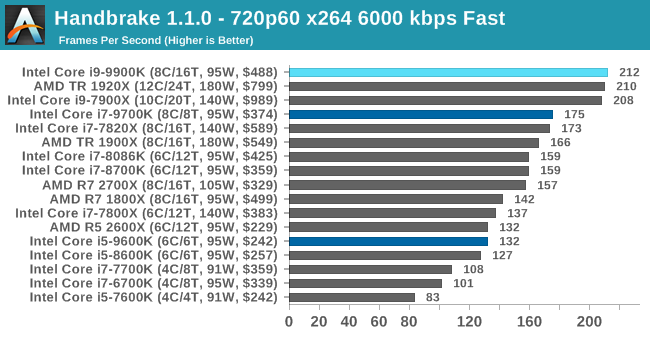
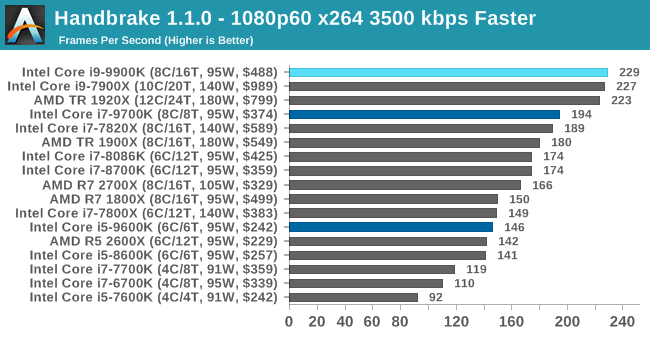
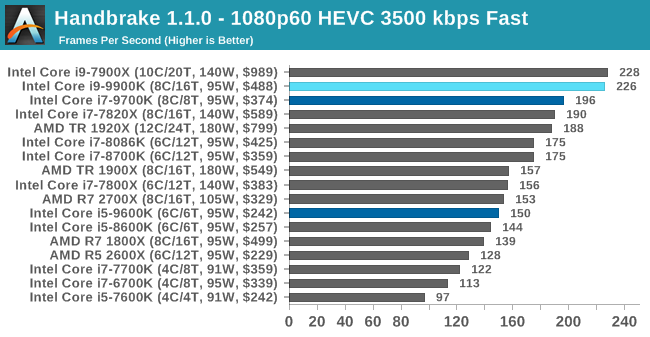
7-zip v1805: Popular Open-Source Encoding Engine
Out of our compression/decompression tool tests, 7-zip is the most requested and comes with a built-in benchmark. For our test suite, we’ve pulled the latest version of the software and we run the benchmark from the command line, reporting the compression, decompression, and a combined score.
It is noted in this benchmark that the latest multi-die processors have very bi-modal performance between compression and decompression, performing well in one and badly in the other. There are also discussions around how the Windows Scheduler is implementing every thread. As we get more results, it will be interesting to see how this plays out.
Please note, if you plan to share out the Compression graph, please include the Decompression one. Otherwise you’re only presenting half a picture.
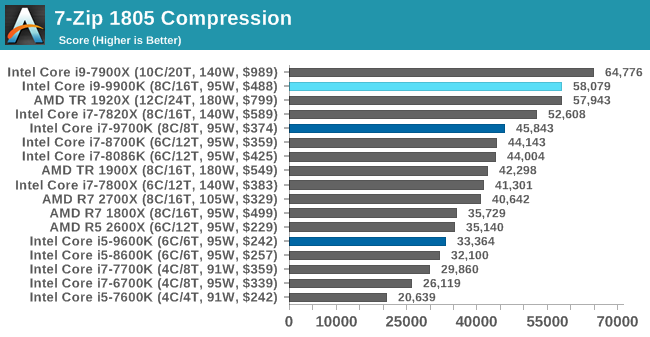
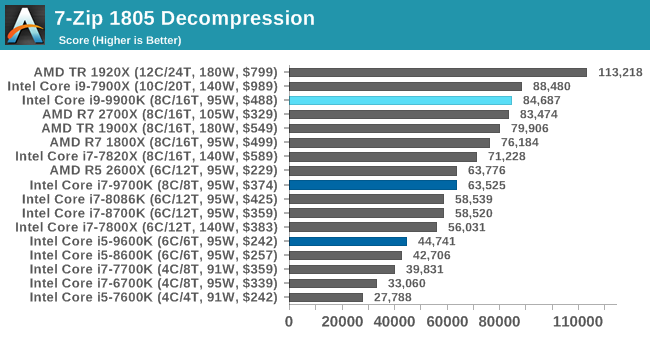
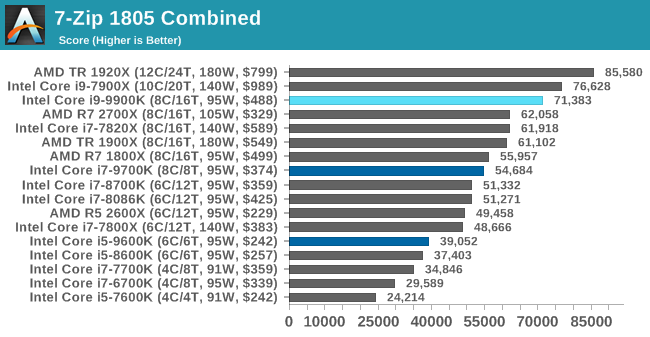
WinRAR 5.60b3: Archiving Tool
My compression tool of choice is often WinRAR, having been one of the first tools a number of my generation used over two decades ago. The interface has not changed much, although the integration with Windows right click commands is always a plus. It has no in-built test, so we run a compression over a set directory containing over thirty 60-second video files and 2000 small web-based files at a normal compression rate.
WinRAR is variable threaded but also susceptible to caching, so in our test we run it 10 times and take the average of the last five, leaving the test purely for raw CPU compute performance.
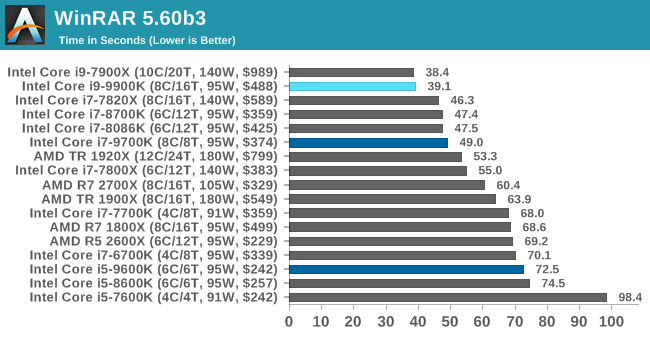
AES Encryption: File Security
A number of platforms, particularly mobile devices, are now offering encryption by default with file systems in order to protect the contents. Windows based devices have these options as well, often applied by BitLocker or third-party software. In our AES encryption test, we used the discontinued TrueCrypt for its built-in benchmark, which tests several encryption algorithms directly in memory.
The data we take for this test is the combined AES encrypt/decrypt performance, measured in gigabytes per second. The software does use AES commands for processors that offer hardware selection, however not AVX-512.
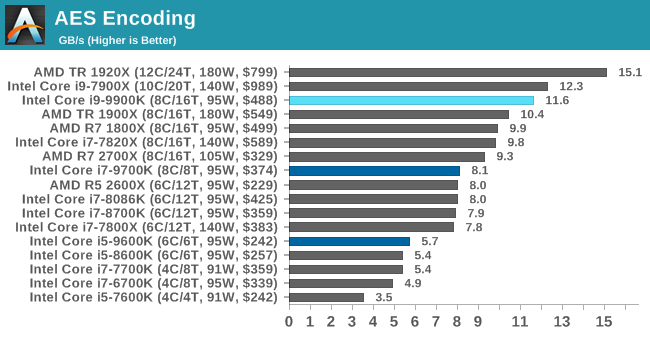










274 Comments
View All Comments
DominionSeraph - Sunday, October 21, 2018 - link
The 8700k is also pulling 150W while the 8086k is 95W. Something's not right there._mat - Wednesday, November 7, 2018 - link
There can be two reasons why that is the case:1) The mainboard settings for Power Limits were different.
2) The 8086K ran into Power Limit 1 while the 8700K was not.
Whatever is the case here, it is no doubt that the 8086K did run into Power Limit 1 after the "Time Above PL1" (= power budget) was depleted. The 95 Watts are exactly the specified TDP of the CPU and Intel recommends this as Power Limit 1 value.
So the problem here is that the Power Limits and Current Limits of the mainboard are not properly documented and seem to differ between the test candidates. While the 8086K obviously had Power Limits in place, the 9th gen CPUs were benched with no limits at all (only temperature limit at 100 °C on a core).
Also, the whole page on power consumption needs rework. The TDP does matter depending on the board and its default settings.
ballsystemlord - Sunday, October 21, 2018 - link
Ian! Many of your tests ( Y-Cruncher multithreaded, apptimer, FCAT - ROTR, WinRAR ), are taking too short of a time. You need some differentiation here! Please make them harder.R0H1T - Sunday, October 21, 2018 - link
>In case the previous comment was missed.I see that the last few pages have included a note about Z390 used because the Z370 board was over-volting the chip? Yet on the Overclocking page we see the Z370 listed with max CPU package power at 168 Watts? Could you list the (default) auto voltage applied by the Asrock Z370 & if appropriate update the charts on OCing page with the Z390 as well?
mapesdhs - Sunday, October 21, 2018 - link
"Intel has promised that its 10nm manufacturing process will ramp through 2019, ..."Ian, what promises did Intel make 2 years ago about what they would be supplying now?
eastcoast_pete - Sunday, October 21, 2018 - link
My guess is that Intel is now printing those promises in 10 nm font size (easily readable with a standard electron microscope). See, they moved to 10 nm by 2018!ballsystemlord - Sunday, October 21, 2018 - link
Actually, fonts are measured in points. So, it's 10pt, and it's rather legible.But, as for products, I don't see any either.
darkos - Sunday, October 21, 2018 - link
nice review, but: please add a flight simulation such as x-plane and prepar3d or fsx. this is an area that is sadly, missing from your reviews.kasboh - Monday, October 22, 2018 - link
Do I see it correctly that there is little benefit of HyperThreading with 8 core CPUs?eXterminuss - Monday, October 22, 2018 - link
I am quiet shocked to see that Anandtech is using a vastly outdated and in parts plainly wrong description for World of tanks:1. The enCore engine ist being used in world of tanks for quiet a while now (10 month)
2.World of tanks is a free to play game, no elements hiden behind a paywall, e. g. no more features for a paying customer than for a freelooter.
3. Since the outadted EnCore benchmark was used, i would have at least expected to see the Results of that benchmark being posted aswell.
Sincerly yours,
eXterminuss a World of Tanks Player